|
|
January 30th, 2016

Here’s a bit of Britain in blue — a 270-7mm WSM F-Classer belonging to Elwood in the UK.
One of the most popular items in our Shooters’ Forum is the ongoing “Pride and Joy” thread. Since 2009, Forum members have posted photos and descriptions of their most prized rifles. Here are some of the most recent “Pride and Joy” rifles showcased in our Forum. Do you have a gun you’d like to see featured there? Just Register for the Forum and you can add your gun to the list.
1. Dasher LowBoy. CigarCop just completed a lovely 6mm Dasher in a yellow/gray laminated PR&T LowBoy stock. CigarCop did the stock inletting and finish work himself. Very nice work indeed.


2. Varmint Special. Here’s a handsome varminter with a beautifully-figured walnut stock. This is one of three rifles Forum Member Dan Hall posted this month.

3. 6mm Trifecta. DixiePPC served up not one but THREE pretty rifles, all with pearlescent paint jobs. Details of the three rigs are provided below. Click the image to see a full-screen version.

Top: 6 PPC for 10.5-lb NBRSA LV Class, 1:14″, .262″-necked SS Hart Barrel chambered and fitted by Doug Pascal, Pearl Black Kelbly Stock, RB/RP Blueprint & Trued 40X Short Action (Glued) with a Doug Pascal Bolt Release. This gun is a 1994 build by Doug Pascal of Craftsmith.
Middle: 6 PPC 13.5lb NBRSA HV Class, 1:14″, .262″-necked SS straight-countour Hart Barrel, Pearl White Kelbly Stock/Aluminum Butt Plate, RB/RP Stolle Panda Action (Glued). Kelbly Double Screw Rings. 1994 Vintage Leupold/Premier BR 36X. This gun is a 1992-vintage Kelbly build for NBRSA Unlimited Class.
Bottom: 6mmBR 17-lb IBS Light Gun Class, 28″, 1:8″, .268″-necked SS Bartlein 5R Barrel tipped with a SS Harrell Spiral Muzzle Brake, Pearl Rust Orange 90s-vintage Lee Six Stock with home made Aluminum Butt Plate, RB/RP Blueprinted and Trued 1995-Vintage 700 Short Action.
4. Simple Elegance. This is Chopper Duke’s handsome 6mm PPC. It features a Remington action in a classic older-style benchrest stock. We like the flawless pale-green finish. Subtle but nice.

5. (Nearly) Identical Duo. Here are a matching pair of customs from Forum member NHM16. He tells us: “I sold my two Savages I was using for F-Open, and had these two built in their place. One reason I upgraded was so I could have two (nearly) identical rifles. The nice thing about these rifles is that most everything interchanges, including the barrels.”

Here Are Specs for Both Guns:
— Panda F-Class action (LRBP, no ejector, 20 MOA dovetail scope base, one action is polished, the other unpolished so I could easily tell them apart).
— PR&T LowBoy stocks with adjustable buttplates, with vents on the side and the bottom.
— Both have Bartlein 32″ 7mm, 1:8″-twist, 5R barrels, chambered in 7mm Walker (basically a .284 Shehane with the addition of a 40 degree shoulder).
— Rifles were built by Richard King (“Kings X” in Forum) in Arlington, Texas, though I did the clear coating myself.
6. First Custom. Here is Forum member Barrys’s very first custom rifle, and it’s a nice one. It features a BAT Machine VR action, Krieger #17 heavy varmint contour, chambered for the 6mmBR Norma with 0.272″ neck. The stock is a Shehane Varmint Tracker with a Walnut-color laminated Obeche stock. On top is a Sightron SIII 8-32x56mm scope in BAT Machine rings.

7. Basic Black. David P. offered this F-TR rig: “A buddy of mine just finished up new rifle for NRA F-TR competition. This rifle is built on a Kelbly action, chambered in .308 Win with a custom, tight-neck match chamber. It’s sitting in a PR&T stock, with a Broughton 32″, 1:11″-twist 5C barrel. The rifle was chambered and built by Brian at Plainfield Precision in Shelby, NC.

Share the post "Behold January’s Pride and Joy Rifles"
January 15th, 2015
After we posted Erik Cortina’s video featuring the trimming of 7mm Shehane cartridges with a Giraud Power Trimmer, many of our readers asked: “What’s a 7mm Shehane? How does it differ from a standard .284 Winchester?” To answer that question, we’re reprising a “cartridge profile” we ran a couple seasons back. This talks about the qualities of the 7mm Shehane, and includes a reamer print. The 7mm Shehane is an excellent “upgrade” to the .284 Win. The added capacity may not seem like much, but it allows some Shehane shooters to reach a higher, optimal velocity node.

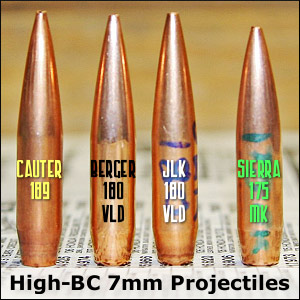 7mm is the caliber to beat in F-Class Open Division (though many guys are looking hard at the big 30s.) With a standard .284 Winchester, or better yet, a .284 Improved, you can drive the high-BC Berger 180gr bullets to competitive velocities. A .284 Improved will shoot well inside a 6.5-284, and you’ll probably get significantly longer barrel life (at least 1800 rounds vs. as little as 1200 for the 6.5mm). 7mm is the caliber to beat in F-Class Open Division (though many guys are looking hard at the big 30s.) With a standard .284 Winchester, or better yet, a .284 Improved, you can drive the high-BC Berger 180gr bullets to competitive velocities. A .284 Improved will shoot well inside a 6.5-284, and you’ll probably get significantly longer barrel life (at least 1800 rounds vs. as little as 1200 for the 6.5mm).
The straight .284 Win is a good cartridge, but in most barrels, it can’t push the 180s at 2900-2950 fps velocity levels*. A lot of barrels will top out at about 2850. That’s where the .284 Shehane comes into play. The .284 Shehane is a slightly modified wildcat that retains the same 35° shoulder as the parent case. However, by blowing the sidewalls out 0.010″, the .284 Shehane picks up about 3.3 grains of extra case capacity. That enhancement makes a BIG difference. The extra boiler room is enough to drive the 180s at 2900-2950 fps with H4831sc. With N560 or Reloder 17 you can go even faster.
Scotland’s Grant Taylor used the .284 Shehane to finish 3rd overall in the 2009 individual F-Class World Championships at Bisley, England. Grant reports: “I have a .284 Shehane and it’s very accurate with superb vertical spreads at 1000 yards. I have to thank Jim Hardy for putting me onto the caliber, it has awesome accuracy. I’m getting 2930-2950 fps with spreads in the 3-5 fps range. I use Hodgdon H4831sc powder, CCI BR2 primers, and pointed 180gr Bergers.”
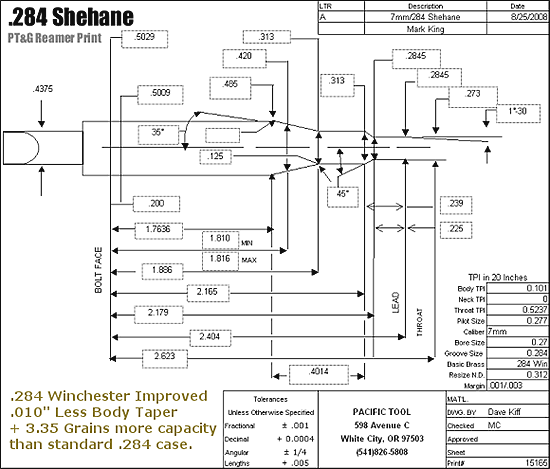
Forum member Jim Hardy has shot the .284 with great success. He tells us: “In my humble opinion, the .284 Shehane is the best balanced long range round there is — bar none. I (perhaps_ have shot more of this chambering than anyone else, and it has proven better than I ever expected. Here is why:
You have to shoot a 30 Cal magnum with a 240gr bullet to equal the performance of most 7mm chamberings with the 180 Berger VLD. With the .284 Shehane, you have a .308 bolt face, medium action, and Lapua brass. You use less powder than the 7 mags, and have great accuracy and ballistics even while fire-forming. The .284 Shehane shoots inside the 6.5 AND the straight 284, the 300 WSM, and the 300 Win Mag with less recoil. The .284 Shehane offers twice the competitive barrel life of the 6.5-284, an easy 2950 fps with H4831 SC, [and it] can run 3000+ with N560 and Reloder 17, which is right there with the 7mm WSM. What is not to love about the 284 Shehane? It is a no-brainer for long range — F-Class or Prone or 1000-yard Benchrest.”
*Some exceptional barrels chambered in straight .284 Win can reach 2900 fps with the 180s. Ryan Pierce, who recently set a 450-24X Pending F-Open record, has a 32″ Brux barrel that is delivering 2900 fps with the straight .284. However, Ryan acknowledges that his velocities are not typical: “A lot of .284 Win barrels top out at around 2850 fps with the 180s.”
Share the post "7mm Shehane — Winning Wildcat for F-Open"
November 16th, 2014
Forum Member Chuck L. (aka “Ridgeway”) has created a handsome duo of 6mm Dashers for competitive benchrest and varmint matches in Pennsylvania. Both guns are built on Kelbly Panda RBLP actions, with Bartlein 8-twist barrels, and Shehane Laminated Tracker Stocks. However, the two rifles are not exact twins, as you can see. One, which we’ll call the Big Dasher, is built on a Shehane ST1000 Tracker stock. The other gun, the Small Dasher, sports Shehane’s “Baby Tracker” stock — a design used with great success by Richard Schatz. The Big Dasher, optimized for 1000-yard competition, also has a slightly longer freebore — 0.136″ vs. 0.104″ for the Small Dasher.



Chuck tells us: “I don’t get out shooting competition as much as I want due to time and family, but when I do compete, I shoot a Groundhog match at Southfork Rifle Club in Beaverdale, PA. Info on Southfork Club events can be found at Southforkrifleclub.com. The Southfork match is basically a 100-, 300- and 500-yard match with one sighter the entire match and 5 shots at each yardage for score. The Small Dasher, with the shorter ‘Baby Tracker’ stock, was set up for the Southfork Rifle Club’s ‘Light Unlimited’ class which has a 13.5-lb max weight.” (Editor: ‘unlimited’ is a misnomer for a weight-limited category.)
Chuck adds: “The Big Dasher with the heavy ST-1000 stock is set up for 1000-yard benchrest matches in Light Gun class. I hope to shoot a couple 1K matches with it at Reade Range in southwest Pennsylvania. I am still in load development for this rifle since it was just finished in January. One ironic thing is, it shoots the same load I’m shooting out of the lighter gun rather well. The only difference between the two chambers is the freebore is roughly thirty thousandths longer on the 1K gun (Large Dasher). I will also shoot this at Southfork in the ‘Heavy Unlimited’ class.”
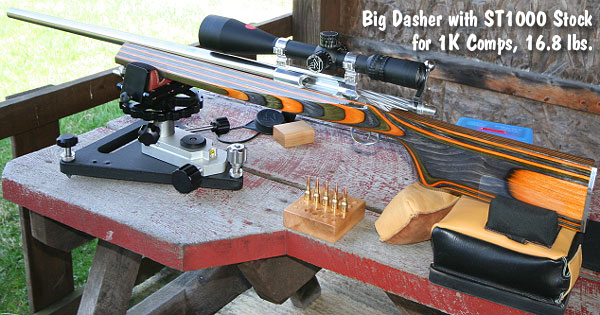
| Specifications for the Dasher Duo:
Small Dasher (13.5-pounder): Chambered for 6mm Dasher with approximately .104 freebore and a .264 NK. (No way of knowing exactly since it freebore was done in a separate operation by Kelbly.) Components are: Shehane Baby Tracker stock, Kelbly Panda RPLB action, Bartlein 1:8″ LV barrel at 26 ¾”, Kelbly Rings, Weaver T36, Jewell trigger. The barrel was chambered by Kelblys and the stock was bedded, glued and balanced by a shooting buddy (Forum Member johara1). I clear-coated the stock with auto urethane. Total weight is 13 lbs., 4 ounces.
Big Dasher (1K Light Gun, 17-pounder): Chambered for 6mm Dasher with a .136 freebore and .264 neck (PTG Reamer). Components are: Shehane ST-1000 stock, Kelbly Panda RPLB action, Bartlein 1:8″ HV 5R barrel at 28″, Shehane +20-MOA rings, Nightforce NXS 12-42x56mm, Jewell trigger. The barrel work, pillar installation, and bedding was done by Dave Bruno. The stock was clear-coated by Chuck with auto urethane. Chuck also made the rear butt plate and balanced the rifle. Total weight: 16 lbs., 13 ounces. |
Dasher Case-Forming: Neck-Turn then Fire-form with Bullets Hard in Lands
To fireform, I turn my cases down to fit the chamber and stop where the false shoulder makes snug contact with the chamber. Fire-forming rounds are loaded up with a 29-grain charge of H4895 or Varget and a 108gr Berger bullet seated hard into the lands about 0.020″ past initial contact with the rifling. It takes about three firings to make a nice clean Dasher case with a sharp shoulder. I anneal about every 3-4 firings. I have many cases that have about 10+ firings on them and they are still shooting well. The primer pockets are a little looser, but still hold a primer.
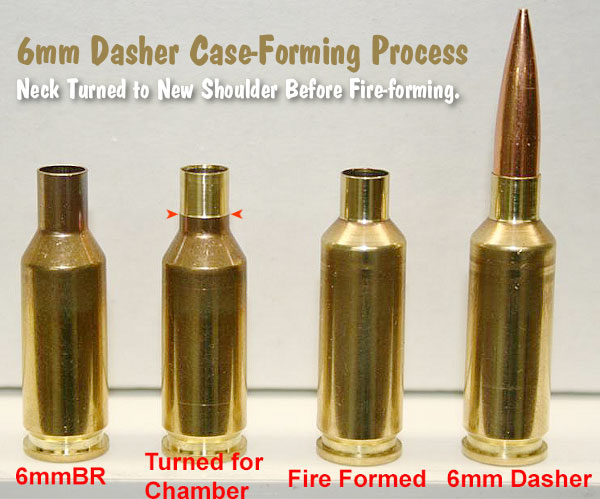
Both Dashers Group in the Ones at 100 Yards
My main bullet for both rifles is the 107gr Sierra MK, loaded with Reloder 15 powder, Lapua cases and CCI 450 primers. My main load for the Small Dasher is 33.0 grains of Reloder 15. This load shoots in the ones at 100 yards. For the Big Dasher, I’m still working on a load, although the same 33.0 grain load shoots in the ones in the heavier gun as well. I’m still looking for more velocity and my ‘max’ node. So far, I’ve gone well above 33.0 grains of RL 15 without pressure signs, but that load produces vertical at 100 yards, so I’m going to tinker with the load until I see pressure or it starts to shoot.
Share the post "Chuck’s Dazzling Dasher Duo — A Pair of Beauties"
April 7th, 2014
Ten shots… 1000 yards … 2.6872″. Think about that. Ten shots you could cover up with a coffee cup. That’s some amazing shooting. Is this a world record? Consider this — we believe this is the smallest 10-shot group ever shot at 1000 yards in any form of rifle competition, by anyone, anywhere, anytime. It is smaller than the existing Williamsport Light Gun and Heavy Gun 1K records. The IBS and NBRSA do not shoot 10 rounds for Light Gun, but this 2.6872″ group is smaller than the current IBS (3.044″) and NBRSA (4.322″) ten-shot HEAVY GUN records.

This amazing group was shot by Jim Richards at the Deep Creek Range outside Missoula, Montana during the 4th Light Gun Relay of a 1000-yard match. Jim was shooting the small 6mm Dasher cartridge with 105gr Berger bullets. Fellow Deep Creek Shooter Tom Mousel says this should be a new world record. The Deep Creek Range shoots under Williamsport rules, with ten shots for Light Gun. The current Williamsport Light Gun record (as listed) is 3.835″ by Cody Finch in 2006, but we’re told that Paul Martinez shot a 3.505″ at Williamsport last year. If approved at 2.6872″, Jim Richards’ new record is 23% smaller than the 3.505″ previous record. That’s remarkable — Jim Richards utterly demolished the previous mark. (As measured, Jim’s group is also smaller than the current Williamsport Heavy Gun record, 2.815″ by Matt Kline in 2010.)
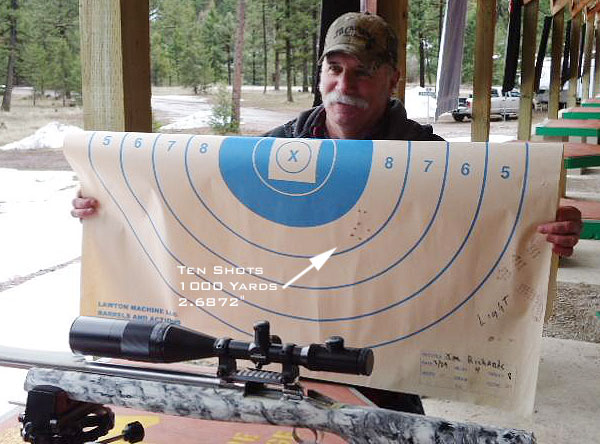
The Record-setting rifle features a Borden action, Shehane ST 1000 fiberglass stock, and Nightforce Benchrest scope. The Krieger barrel was chambered by King Machine for the 6mm Dasher, with a 0.269″ neck and 0.103″ freebore. Jim Richards was running Berger 105gr Hybrid bullets.
The rifle was purchased used from Tim Claunch. We suspect Tim wishes he had not parted with it! Any gun that can put ten shots under three inches at 1000 yards is a “keeper”, that’s for sure.
Forum member Wayne B. says: “I am really happy for Jim. He has asked 1000 questions, slept in his pickup, upgraded his equipment, bought a rifle from another friend of mine and now he is a world record-holder. The men and women who shoot at Deep Creek in Missoula Montana are the best group of shooters in the world bar none! They will give you all the info you need to win and if you don’t have what you need they will loan it to ya, up to and including a rifle and ammo.”
Share the post "Best 10-Shot, 1000-Yard Group in History — Be Amazed"
March 16th, 2014
Most long-range benchrest stocks are three inches wide because that used to be the max width under the rules for Light Gun Class. Many folks may not realize that the IBS, the NBRSA, and the Williamsport organizations have all modified their Light Gun rules to allow wider forearm widths in registered competition. A wider stock provides increased stability and resists rotation (torquing) as the gun is fired. If you’re building a new Light Gun, you may want to consider a 4″-wide or 5″-wide forearm. Do check the rules of your local club or regional organization to ensure the wider width is allowed in the matches you attend. And if you plan to shoot F-Class as well, stick to 3″. Under F-Class (Open) rules, “the width of the rifle’s forend shall not exceed 76mm (approximately 3 inches)”.
Wider Forearm Stock Options
Most stock-makers still only offer a 3″-wide forearm width with their Light Gun long-range benchrest stocks. However, there are some other options. On request, Joel Russo, Russo Rifle Stocks, can cut a stock with 4″-wide forearm, but that’s not a standard pattern.
If you want a 4″-5″ wide version of the popular MBR Tooley-style long-range stock, Bill Shehane offers a ‘Big Dawg’ version of his MBR Tracker stock. This features a longer, deeper, and wider fore-end for added stability and more resistance to torque with the heavy calibers. Along with having a wider forearm, the Big Dawg stock is cut 4″ longer than a standard Shehane ST-1000 Tracker. This provides a “longer wheelbase” for better balance with very long (30″+) barrels. (The ST-1000 itself is 3″ longer than most benchrest stocks.) The Big Dawg is available with a 4″-wide or 5″-wide forearm, and will handle barrels up to 40″ in length and 1.5″ in diameter. In the top photo, taken by Forum member Preacher, you see a 4″-wide Big Dawg next to a normal ST-1000 Tracker. (Both stocks are symmetrical; there is distortion caused by wide-angle lens.)


This color pattern is what Bill calls “Prairie Dog Camo”, a Rutland laminate in orange and dark gray, with olive ‘accent’ layers. The price for a ‘Big Dawg’ in Rutland laminate is $625. In African Obeche wood (any color choice), the price is $855.00. For more info, contact Bill Shehane at (704) 824-7511, or visit his website, www.ScopeUsOut.com.
Wide Stocks for Rimfire Benchrest
Ultra-wide stocks are also legal in many rimfire benchrest disciplines. Shown below is a rimfire rifle built with a 4″-wide Shehane Big Dawg stock. This gun is used in ARA Unlimited competition. Extra-wide stocks like this can also be used in the IR 50/50 Unlimited Class and RBA Unlimited Class.
Why use a wide stock for rimfire where recoil is not an issue? The extra width definitely provides more stability in the bags. This is noticeable when cycling the action during the loading process — the gun shows less “wiggle” when opening and closing the bolt. The larger mass of wood also, potentially, provides additional vibration damping. A wider stock design carries more weight (per inch of length) and more mass is distributed outboard. Initial testing shows that the wide stocks work well for rimfire shooters who like to grip their gun — the gun feels “planted” with less wobble when the stock is gripped or cheeked by the shooter.

Share the post "Super-Wide Forearms Add Stability to Benchrest Rifles"
October 10th, 2013
Some folks think of laminated stocks as modestly-priced, “low-tech” alternatives for varmint and hunting rifles. In fact, for shooting disciplines that do not demand ultra-light weight, good laminated stocks give up nothing in performance to the most sophisticated composite stocks. And with laminates, it is relatively easy to fine-tune fit and ergonomics to suit the individual shooter. Available in a wide choice of colors, laminated stocks can also be very handsome.
In our Shooters’ Forum, you’ll find a thread showcasing laminated stocks. It’s worth viewing. There are many interesting designs, and a wide variety of rifles ranging from “walking varminters” to long-range prone rifles. CLICK HERE to View Laminated Stock Forum Thread
GRS Laminated Stock from Norway (Imported by Kelbly’s)


FalconPilot’s Shehane Tracker in Sierra Laminate with Clearcoat

20 Practical Varminter (UK Custom posted by PNSE)


Prone Rifle by Carl Bernosky (posted by 1Shot)

F-Class (Special) by Alex Sitman (posted by J. DeKort)
 Veteran’s Team Rifle #2 by Doan Trevor (posted by GermanS1) Veteran’s Team Rifle #2 by Doan Trevor (posted by GermanS1)


Share the post "Laminated Stocks Offer Value, Performance, and Style"
March 16th, 2012
The Hickory Groundhog and Egg Shoot, the richest varmint shoot East of the Mississippi, is just three weeks away. The hugely popular Hickory Shoot will be held this year on Saturday, April 7, 2012. The basic entry fee is just $25.00 per gun. That’s cheap for a chance to win a bundle of cash, plus valuable prizes such as Shehane stocks and Nightforce optics.
Anatomy of a Hickory-Winning Rig — Brady’s Record-Setting 6BR
If you wonder what kind of rifle can win the big money at the Hickory Shoot, have a look at Terry Brady’s 42-lb 6BR. In 2010, Terry Brady won the Custom Class in the Hickory Shoot, setting an all-time record with a 99 score*. Terry was shooting a straight 6mmBR with 105gr Berger VLD bullets. His rifle looks “normal”, but it was actually purpose-built for Groundhog shoots, which have no weight limit in Custom Class. The fiberglass Shehane Tracker stock was stuffed with lead shot from stem to stern, so that the gun weighs nearly 42 pounds with optics. The Hickory winner, smithed by Mike Davis of Zionville, NC, featured a BAT DS action with a straight-contour, gain-twist Krieger barrel. The twist rate starts at 1:8.7″ and increases to 1:8.3″ at the muzzle. Terry was shooting a relatively moderate load of 30.5 grains Varget with Danzac-coated bullets. This load absolutely hammered, but Terry thinks the gun might shoot even better if the load was “hotted up a little.”

Minimal Recoil and Insane Accuracy at 500 yards
In the picture above you see the Hickory winner fitted with a 5″-wide front plate. This was crafted from aluminum by Gordy Gritters, and Terry said “it only adds a few ounces” to the gun. Mike Davis installed threaded anchors in the fore-end so the plate can be removed for events where forearm width is restricted to 3″. The plate is symmetrical, adding 1″ extra width on either side of the Shehane Tracker stock. Gordy can also craft a 5″ plate that offsets the rifle to one side or the other. Terry hasn’t experimented with an offset front bag-rider, but he thinks it might work well with a heavier-recoiling caliber. Terry actually shot most of the Hickory match without the front plate so he could use his regular 3″-wide front bag. Even with the plate removed, Terry’s Hickory-winning 6BR barely moves on the bags during recoil, according to Terry: “You just pull the trigger and with a little push you’re right back on target.” With this gun, Terry, his son Chris, Chris’s girlfriend Jessica, and Terry’s friend Ben Yarborough nailed an egg at 500 yards four times in a row. That’s impressive accuracy.
*The Hickory employs “worst-edge” scoring, meaning if you cut a scoring line you get the next lower score. One of Terry’s shots was right on the edge of the white and another was centered right between white and black at 3 o’clock. Accordingly he only received 27 points for each of the 300 and 500-yard stages. Under “best-edge” scoring, Terry would have scored even higher.

CLICK HERE for 2012 Hickory Groundhog & Egg Shoot Info Sheet (PDF)
Share the post "Hickory Groundhog and Egg Shoot Slated for April 7, 2012"
June 7th, 2011
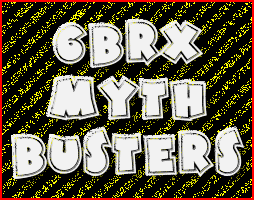 Dispelling Some 6mm BRX Myths, by Robert Whitley Dispelling Some 6mm BRX Myths, by Robert Whitley
I recently had an interesting and fact-filled conversation with Bob Crone (the inventor of the 6mm BRX) about his BRX. Bob actually called me because he was concerned that there are a lot of myths and about his 6mm BRX and he wanted to “set the record straight” on a few things. Here’s my summary of some topics we discussed:
Myth One: Bob made his 6mm BRX chamber by running a 6mm BR reamer in too deep.
Truth: There is no truth to Myth One. Bob said he specifically designed the BRX reamer and had it made with the head space he specified and a neck length appropriate for his newly designed 6mm BRX wildcat cartridge.
Myth Two: In the course of making up his 6mm BRX, Bob had a version with a .120″ longer head space than a 6mm BR Norma.
 Truth: Bob was clear that his original design for the 6mm BRX always had a .100″ longer head space than a 6mm BR and that he never deviated from that. Right after Bob started working with his 6mm BRX, Bill Shehane came forward with a 6mm BRX version he made up that had a .120″ longer head space, and thus the confusion started. In truth, the original 6mm BRX always was (and still is) a chambering with a head space .100″ longer than a 6mm BR Norma. Truth: Bob was clear that his original design for the 6mm BRX always had a .100″ longer head space than a 6mm BR and that he never deviated from that. Right after Bob started working with his 6mm BRX, Bill Shehane came forward with a 6mm BRX version he made up that had a .120″ longer head space, and thus the confusion started. In truth, the original 6mm BRX always was (and still is) a chambering with a head space .100″ longer than a 6mm BR Norma.
Myth Three: The BRX was originally set up for 105-107gr bullets.
Truth: Bob said he set up his original reamer with a zero freebore and he has his gunsmith use a throater to throat whatever chamber was being made to where he wanted a particular bullet to touch the lands. Bob said he originally started with a 1:10″ twist barrel and shot a bunch of the 95gr VLDs and also 87gr bullets. Later he used an 8.5″ twist barrel for the heavier bullets.
Myth Four: The original BRX was set up also for use with Remington BR Brass.
Truth: Bob said he always used Lapua brass. He originally was an avid reader of Precision Shooting magazine and saw that the .262″ neck-turn neck was working real well with the 6 PPC and 6mm BR bench rest shooters and he decided to try to go with something that was already working well for 6mm shooters. He says his original reamer had a .262″ neck, but he also has a .272″ “no-neck-turn” version that he used on some of his rifles. He said the Lapua brass was so good and consistent, that for some rifles he just “didn’t want to mess with it” so he went with the “no-neck-turn” .272″ neck too.
 Myth Five: The “false shoulder” method was used to make brass. Myth Five: The “false shoulder” method was used to make brass.
Truth: Bob said he never used the “false shoulder” method to make 6mm BRX brass, he just loaded 6mm BR brass with a bullet well into the lands of the BRX chamber and fire-formed brass that way. He noted that the accuracy with some of the fire-forming rounds was “outrageous” (i.e. outrageously good that is), so much so, they were shot in matches sometimes.
Myth Six: The 6mm BRX has a blown-out or straightened out body.
Truth: Bob said he kept the basic body taper of the 6mm BR cartridge. He wanted the cartridge to be an easy and inexpensive (but high performance) 6mm wildcat, and the original design was (and still is) set up to use readily available 6mm BR dies (up off the shell holder about .100″ from the normal position).
Author’s note: It was a most enjoyable experience to talk to Bob Crone. He is not only still passionate about his 6mm BRX, but he has a commanding knowledge of it as well.

Reamer Print provided by AR-X Enterprises LLC, www.6mmAR.com.
Share the post "The 6mm BRX — Myth-Busting with Bob Crone"
|






















 7mm is the caliber to beat in F-Class Open Division (though many guys are looking hard at the big 30s.) With a standard .284 Winchester, or better yet, a .284 Improved, you can drive the high-BC Berger 180gr bullets to competitive velocities. A .284 Improved will shoot well inside a 6.5-284, and you’ll probably get significantly longer barrel life (at least 1800 rounds vs. as little as 1200 for the 6.5mm).
7mm is the caliber to beat in F-Class Open Division (though many guys are looking hard at the big 30s.) With a standard .284 Winchester, or better yet, a .284 Improved, you can drive the high-BC Berger 180gr bullets to competitive velocities. A .284 Improved will shoot well inside a 6.5-284, and you’ll probably get significantly longer barrel life (at least 1800 rounds vs. as little as 1200 for the 6.5mm).














 Veteran’s Team Rifle #2 by Doan Trevor (posted by GermanS1)
Veteran’s Team Rifle #2 by Doan Trevor (posted by GermanS1)



 Dispelling Some 6mm BRX Myths, by
Dispelling Some 6mm BRX Myths, by  Truth: Bob was clear that his original design for the 6mm BRX always had a .100″ longer head space than a 6mm BR and that he never deviated from that. Right after Bob started working with his 6mm BRX, Bill Shehane came forward with a 6mm BRX version he made up that had a .120″ longer head space, and thus the confusion started. In truth, the original 6mm BRX always was (and still is) a chambering with a head space .100″ longer than a 6mm BR Norma.
Truth: Bob was clear that his original design for the 6mm BRX always had a .100″ longer head space than a 6mm BR and that he never deviated from that. Right after Bob started working with his 6mm BRX, Bill Shehane came forward with a 6mm BRX version he made up that had a .120″ longer head space, and thus the confusion started. In truth, the original 6mm BRX always was (and still is) a chambering with a head space .100″ longer than a 6mm BR Norma. Myth Five: The “false shoulder” method was used to make brass.
Myth Five: The “false shoulder” method was used to make brass.





